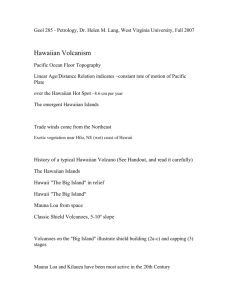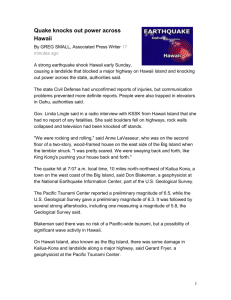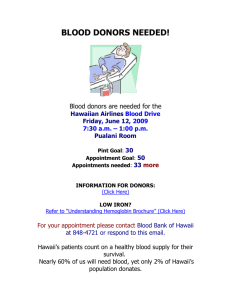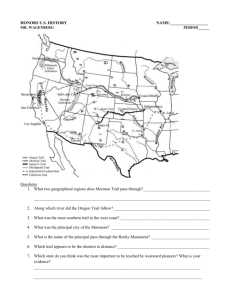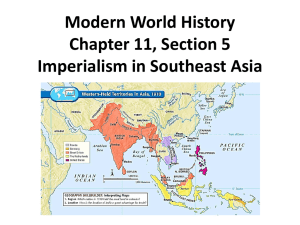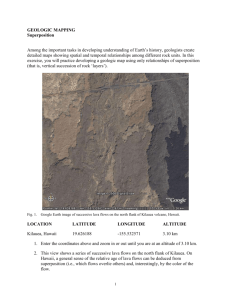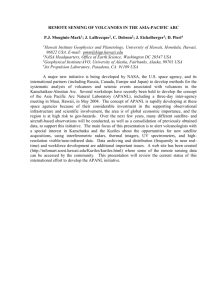Hawaii Volcanoes by Land Sea and Sky
advertisement
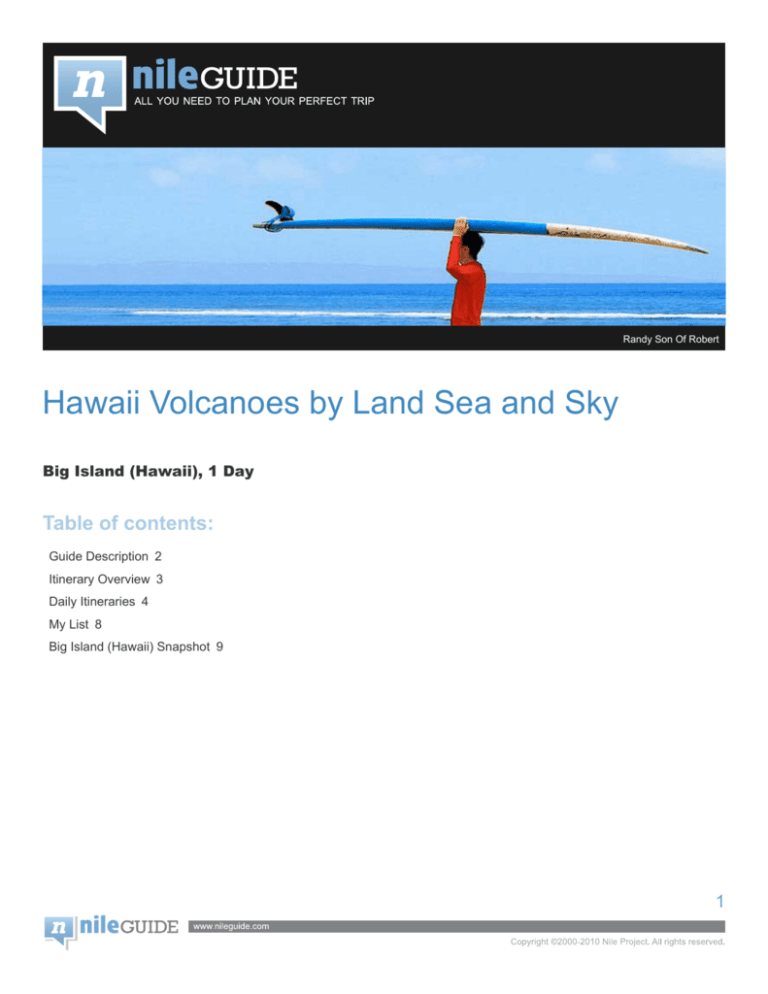
Randy Son Of Robert Hawaii Volcanoes by Land Sea and Sky Big Island (Hawaii), 1 Day Table of contents: Guide Description 2 Itinerary Overview 3 Daily Itineraries 4 My List 8 Big Island (Hawaii) Snapshot 9 1 Guide Description AUTHOR NOTE: The volcano has haunted and amazed many for generations. Kilauea has been active for over 25 years and the stories and mystical sightings of the hot-tempered Hawaiian goddess Pele lend even more to the mystery and fascination. This tour allows you to embrace the legends and lava of the volcano and make the memories yours. 2 things to do restaurants hotels nightlife Itinerary Overview Day 1 - Big Island (Hawaii) DAY NOTE: Get an early start, this trip will take you from sun up to after sunset especially if starting from Kona. From the Keahole –Kona Airport, the drive to the Hilo Airport should take about 3 hours. The drive is an easy and scenic one along Hawaii Belt Road via Waimea, along the Hamakua Coast and finally into Hilo Airport. Helicopter trips are best reserved in advance. Book something between 9-11 in the morning. The shortest trips offered last between 45-50 minutes and those are best for this all day adventure. Helicopter trips have been known to be cancelled at the last minute so, book early in the day so time will not be wasted on waiting time waiting on a canceled flight. . . From Kona, follow Hawaii Belt Road for about 100 miles into Hilo and straight into the airport parking area. Helicopter boarding areas are located on the extreme left of the airport terminal so park accordingly. Located just outside the main entrance to the Hilo Airport, a stop at Ken’s Pancake House is more than just an excuse for fluffy Big Island style pancakes, it’s a great inexpensive spot to grab an inexpensive meal and get a glimpse into the islands locals. . . Next stop is Hawaii Volcanoes National Park. At the entrance to the airport turn left onto Hawaii Belt Road and follow it for about 25 miles and follow the signs to the park entrance. Once inside the park, head to the visitors center for updates on the volcanic activity, maps and other park information. Be sure not to miss the short hiking trails around the visitor’s center, Thurston Lava Tube and the Chain of Craters road where you can drive all the way to point where the new young flows have blocked the road. A visit to Volcano House is nice for lunch although the restaurant is more of a tourist stop than a fine eatery. There is also a gallery and a gift shop. . . The drive to Issac Hale Beach Park will take at least 90 minutes. Be sure to leave the park by 3pm to be sure not to miss the boat. Reservations for Lava Oceans Adventures should be made well in advance. The boats can carry only 24 per people and it is very popular especially at times when the volcano is extremely active. Return to Kona via Hawaii Belt Road. Expect to arrive back at Kona Airport in about 4.5 hours. . Crater Rim Scenic Drive Around the rim of the Kilauea Caldera Chain of Craters Scenic Drive See several volcanic formations Kilauea Overlook Excellent view of Kilauea Caldera Halemaumau Trail Through the Kilauea Caldera Puu Loa Petroglyphs Trail Leads to a Hawaiian petroglyphs. Iliahi Trail Short and easy with views of Kilauea Caldera Crater Rim Trail Circle the rim Safari Helicopters The island by sky Kilauea Visitor Center A good place to become oriented Hawaii Volcanoes National Park Active volcanism 3 Day 1 - Big Island (Hawaii) QUICK NOTE DAY NOTE: Get an early start, this trip will take you from sun up to after sunset especially if starting from Kona. From the Keahole – Kona Airport, the drive to the Hilo Airport should take about 3 hours. The drive is an easy and scenic one along Hawaii Belt Road via Waimea, along the Hamakua Coast and finally into Hilo Airport. Helicopter trips are best reserved in advance. Book something between 9-11 in the morning. The shortest trips offered last between 45-50 minutes and those are best for this all day adventure. Helicopter trips have been known to be cancelled at the last minute so, book early in the day so time will not be wasted on waiting time waiting on a canceled flight. . . From Kona, follow Hawaii Belt Road for about 100 miles into Hilo and straight into the airport parking area. Helicopter boarding areas are located on the extreme left of the airport terminal so park accordingly. Located just outside the main entrance to the Hilo Airport, a stop at Ken’s Pancake House is more than just an excuse for fluffy Big Island style pancakes, it’s a great inexpensive spot to grab an inexpensive meal and get a glimpse into the islands locals. . . Next stop is Hawaii Volcanoes National Park. At the entrance to the airport turn left onto Hawaii Belt Road and follow it for about 25 miles and follow the signs to the park entrance. Once inside the park, head to the visitors center for updates on the volcanic activity, maps and other park information. Be sure not to miss the short hiking trails around the visitor’s center, Thurston Lava Tube and the Chain of Craters road where you can drive all the way to point where the new young flows have blocked the road. A visit to Volcano House is nice for lunch although the restaurant is more of a tourist stop than a fine eatery. There is also a gallery and a gift shop. . . The drive to Issac Hale Beach Park will take at least 90 minutes. Be sure to leave the park by 3pm to be sure not to miss the boat. Reservations for Lava Oceans Adventures should be made well in advance. The boats can carry only 24 per people and it is very popular especially at times when the volcano is extremely active. Return to Kona via Hawaii Belt Road. Expect to arrive back at Kona Airport in about 4.5 hours. . 4 Day 1 - continued... contact: tel: +1 808 246 0136 http://www.safarihelicopters.c om location: P.O. Box 1941 Kailua-Kona HI 96766 hours: by advance reservations only contact: tel: 808-985-6000 fax: 808-985-6004 www.nps.gov/havo/ location: P.O. Box 52 Hawai'i National Park HI 96718 contact: tel: 808-985-6000 fax: 808-985-6004 www.nps.gov/havo/ location: Highway 11 Hawai'i National Park HI 96785 1 Safari Helicopters DESCRIPTION: It is nearly impossible to take in all that Hawaii has to offer, if you are traveling by car. Safari Helicopter Tours offers a comfortable way to view the volcano from above, see Parker Ranch, the Kona Coast and the waterfalls of Waipio Valley; all may be viewed within the space of a few hours. It is the best way to see the major sights in a relatively short period of time. The air-conditioned helicopters offer forwardfacing seats and 180-degree views. A video and sound system narrates the tour as you go and is also available for purchase. © wcities.com wcities 2 Kilauea Visitor Center DESCRIPTION: Kilauea Visitor Center, located just inside the park entrance, offers visitor information and exhibits. Park Rangers are on duty at this site during business hours. This is a good place to get information about current water and trail conditions and volcanic activity. Films and videos are shown in the auditorium throughout the day. Hawaii Natural History Association operates a bookstore at this location with an extensive selection of books, maps, videotapes, slides and other educational items. Photo courtesy of Kilauea Visitor Center 3 Hawaii Volcanoes National Park DESCRIPTION: Visitors to this national park can enjoy a diverse environment of volcanic mountains and craters, lava flows and rain forests. Over half of the park is designated wilderness and provides an unusual landscape for a variety of recreation opportunities. Located just inside the park entrance, Kilauea Visitor Center offers visitor information and exhibits. Films and videos, highlighting the park's special features and current eruption, are shown in the auditorium. A schedule of Ranger-led walks/talks is posted on the Ranger Activities bulletin board in the visitor center at 9:00am each morning. Located along Crater Rim Drive, three miles from the park entrance, the Thomas A. Jaggar Museum offers earth science displays and features murals depicting Hawaiian culture. An adjacent overlook offers a panoramic view of Kilauea Caldera and Mauna Loa. Hawaii Volcanoes National Park is located on the Island of Hawaii, 96 miles southeast of Kailua-Kona and 30 miles southwest of Hilo. . 5 Day 1 - continued... contact: tel: 808-985-6000 fax: 808-985-6004 www.nps.gov/havo/ location: P.O. Box 52 Hawai'i National Park HI 96718 contact: tel: 808-985-6000 fax: 808-985-6004 www.nps.gov/havo/ location: P.O. Box 52 Hawai'i National Park HI 96718 contact: tel: 808-985-6000 fax: 808-985-6004 www.nps.gov/havo/ location: P.O. Box 52 Hawai'i National Park HI 96718 contact: tel: 808-985-6000 fax: 808-985-6004 www.nps.gov/havo/ location: P.O. Box 52 Hawai'i National Park HI 96718 4 Crater Rim Scenic Drive DESCRIPTION: Crater Rim Drive is an eleven-mile loop road that encircles the summit Caldera, passes through the Ka`u Desert and tropical rain forest and provides access to well-marked scenic stops and short walks. This road provides access to Kilauea Visitor Center, Jaggar Museum, Halemaumau Overlook and Thurston Lava Tube. Several trails are accessible from this route, including Crater Rim Trail, Devastation Trail and Ka'u Desert Trail. You should allow one to three hours to tour this scenic drive, depending on how often you stop. Turn to the left as you enter Hawaii Volcanoes National Park and follow signs toward the Kilauea Visitor Center. This is the beginning of Crater Rim Scenic Drive. Photo courtesy of Crater Rim Scenic Drive. 5 Chain of Craters Scenic Drive DESCRIPTION: This road begins at Crater Rim Drive and leads 20 miles along the southeastern slopes of Kilauea to the Puna coast. Along the way it descends 3,700 feet and provides sweeping views of lava flows and coastline. The road ends abruptly where a 1995 lava flow crosses it. Depending on changing volcanic activity, there may be opportunities for viewing active lava flows. No food or fuel is available along the Chain of Craters Road. Follow the signs for Crater Rim Drive in Hawaii Volcanoes National Park. Chain of Craters Road leaves Crater Rim Drive between Thurston Lava Tube and Halemaumau Overlook. Photo courtesy of Chain of Craters Scenic Drive 6 Kilauea Overlook DESCRIPTION: This site lies on your left approximately .7 miles from Steaming Bluffs. It is marked as a picnic area, but is also a great spot for viewing the Kilauea Caldera and Halema'uma'u Crater. The view from this site is similar to that found at the Jaggar Museum, but it is usually much less crowded. Photo courtesy of Kilauea Overlook 7 Halemaumau Trail DESCRIPTION: Halemaumau Trail begins at the Kilauea Visitor Center in Hawaii Volcanoes National Park, descends 400 feet through rain forest, crosses the desert-like Kilauea Caldera and ends at Halemaumau Overlook. The trail is three and a half miles long, one way and rated as moderately difficult by the Park Service. The return trip may be made via Crater Rim Trail or another combination of short paths. Interesting volcanic formations along the path include: pahoehoe lava flows, steam vents, spatter ramparts and craters. Photo courtesy of Halemaumau Trail 6 Day 1 - continued... The trail continues into the Calera from the Halemaumau Overlook. contact: tel: 808-985-6000 fax: 808-985-6004 www.nps.gov/havo/ location: Hawai'i National Park HI 96718 contact: tel: 808-985-6000 fax: 808-985-6004 www.nps.gov/havo/ location: P.O. Box 52 Hawai'i National Park HI 96718 contact: tel: 808-985-6000 fax: 808-985-6004 www.nps.gov/havo/ location: Crater Rim Dr Hawai'i National Park HI 96718 8 Puu Loa Petroglyphs Trail DESCRIPTION: The trail to Pu'u Loa Petroglyphs leads two miles eastward from Chain of Craters Road. This trail traverses older lava flows to one of Hawai'i's most extensive petroglyph fields. It is considered an easy to moderate hike by the Park Service and should take one and a half hours. The petroglyphs are fragile and hikers are encouraged to remain on the trail. Puu Loa Trail begins at the Pu'u Loa parking area between mile markers 16 and 17 on Chain of Craters Road. Photo courtesy of Puu Loa Petroglyphs Trail 9 Iliahi Trail DESCRIPTION: Iliahi (Sandalwood) Trail leads through a rain forest, past steam vents and offers views of Kilauea Caldera, Halema'uma'u Crater and Mauna Loa. This hike is rated easy to moderate by the Park Service. It leads along a one and a half mile loop, that takes approximately one to two hours to complete. The trail begins to the right of the Volcano House Hotel. Conditions along this trail may be hot so bring plenty of water. The Park Service cautions visitors to stay on the maintained trail and beware of steam vents, earth cracks and cliffs along the route. The trail begins to the right of the Volcano House Hotel in Hawaii Volcanoes National Park. Photo courtesy of Iliahi Trail A Crater Rim Trail DESCRIPTION: Crater Rim Trail encircles Kilauea's summit Caldera closely following the path of Crater Rim Road. This is a challenging and long day hike, that passes through varied terrain, including a desert and rain forest. Views of Halemaumau and Keanakakoi Craters and Mauna Loa are excellent from this 11-mile path. The trail begins at the Kilauea Visitor Center and leads along the northern crater rim. On the southern side of the crater the trail leads away from the rim, with the road between the trail and the crater. This obstructs hikers' views from The Jaggar Museum to the Thurston Lava Tube. A short spur trail leading north to the Halemaumau Overlook is accessible from Crater Rim Trail. Bring water and food and be prepared for hot and dry, and wet and windy weather. Expect sulfur fumes in the Halema'uma'u Crater and southwest rift zone area. To get there follow Crater Rim Road to the Kilauea visitor center. The trailhead begins from the visitor center parking area. National Park Service 7 My List contact: tel: +1 808 935 8711 http://national.citysearch.com/ profile/3193596/hilo_hi/ken_s _house_of_pancakes.html location: 1730 Kamehameha Avenue Hilo HI 96720 hours: 24 hrs 1 Ken's House of Pancakes DESCRIPTION: While a rare and precious commodity in almost any town, the 24-hour restaurant is almost unheard of in Hawai'i. Thank goodness then for Ken's HOP, which not only serves all night long, but is reputed to serve the very best breakfasts on the Island of Hawai'i. It has won a half-dozen people's choice awards in the past few years for service, food quality and all-around excellence. Everything from the famous pancakes to spaghetti to Kalua pig is on the extensive menu. All-you-can-eat specials are featured on Wednesday and Sunday. © wcities.com Photo courtesy of Ken's House of Pancakes 8 Big Island (Hawaii) Snapshot Local Info The island of Hawaii is a collection of contrasts, and extremes. This island is not only the furthest south in the Hawaiian Island chain, it happens to be the location of the southernmost point in the United States. In contrast it is also the location of the highest mountain in the world. Mauna Kea rises 33,000 feet when measured from the sub-oceanic base. Mauna Kea is also home of the highest freshwater lake in the United States. Lake Waiau sits just over the 13,000 ft level near the summit of Mauna Kea. Mauna Kea is also where the clearest air is found on the planet, hence many of the world's largest telescopes are located on the summit. The Big Island is also a contrast of fire and ice. Snow covers the peaks of Mauna Kea and Mauna Loa during winter months while the volcanic eruption at Kilauea Volcano has been continuously active for over 15 years. North and South Kona Most visitors to the Big Island first arrive at the Kona International Airport at Keahole. Located in the North Kona, the architecture of the airport is definitively Polynesian. Ticket counters and gate areas are a collection of small buildings resembling groupings of village huts. The open-air setting is unique and provides easy one level access to everything from checkin kiosks to baggage claim and ground transportation. Turn south from the airport and you will be well in the area that encompasses North and South Kona. This area includes the majority of the original town and tourist district of Kailua-Kona along with the largest business, industrial and commercial area on the Leeward side of the Big Island. Here you will find doctors, big box stores, restaurants, cultural sites, and many shops and boutiques. Some of the must-sees are Laaloa Beach Park, Ahu'ena Heiau and Hulihe'e Palace which are both along the waterfront. Also along the waterfront is the main thoroughfare called Alii Drive. It is the place to browse shops, dance the night away, watch the green flash over a local larger or have a romantic sunset dinner for two. North and South Kohala Named after the oldest mountains on the island, the landscape of the Kohala Coast is sunny, hot and dry with beautiful sunset and endless ocean views, numerous lava fields and only a few white sand beaches. There are fabulous views of not only Mauna Kea, Mauna Loa, the Kohala Mountains and Hualalai, but on a clear day views of the eastern slope of Haleakala can be seen in the distance. Some of the best and more opulent resorts in the state are located along this coast. The Hilton Waikoloa village is probably the most fantastic followed by the very opulent Mauna Lani, the Fairmont Orchid and the Mauna Kea Beach and Hapuna resorts farther north. Also noteworthy in the area is Spencer Beach Park and Hapuna Beach Park. These two beach parks are one of the best in the state not to mention the island. If there is one thing that brings people from around the world to the Kohala Coast, it is the golf. Most area courses rank among the top 100 in the United States. Hapuna Golf Course, Francis Brown I& II and the Waikoloa Village Golf Courses are all worldrenowned. One of the more interesting areas in South Kohala is Waimea. Located at the 2500 foot elevation, Waimea town is unique in all Hawaii. Breezy sunny days and cool nights, Waimea is a combination of cowboys, scientists and upscale island homes and not just another sleepy Hawaii plantation town. Waimea, or Kamuela as it is sometimes referred to, is a ranching town. It sits adjacent to one of the largest working cattle ranches in the country, Parker Ranch, and is steeped in tradition, culture and history. Waimea is also the location of the administrative support for the Keck and Canada France Telescopes that sit on the summit of Mauna Kea in full view from the heart of town on a clear day. Hamakua From the sleepy town of Honokaa to the tiny town of Paauilo, the Hamakua coast is known for beautiful ocean vistas, waterfalls, valleys and lush tropical landscapes. Life is slow, unhurried. It is a place where relationships mean more than time and the beep of a car horn is more of a greeting than a reproach. Just a few miles north from the center of Honokaa Town is Waipio Valley. A tour is recommended to visit the valley floor where streams, taro patches and waterfalls can be viewed, otherwise, a stop at the lookout to enjoy the valley vistas is something is simply not to be missed. Also a part of Hamakua is the Mauna Kea State Recreation Area. Accessible via Saddle Road from either Kona or Hilo, a visit to the summit would necessitate a four wheel drive and a call to the check on the area weather conditions. A drive along the Hamakua coast will take you through eucalyptus forests, pasture lands over bridges and through valleys. It is a relaxing experience and one of the more special parts of the island. North and South Hilo Located just south of Hamakua along the windward side of the island the Hilo area encompasses the area from Ookala to the quiet waterfront town of Hilo. The area is much like the Hamakua Coast to the casual untrained eye, a closer look will reveal some of the most beautiful waterfalls, picturesque parks and charming towns in the state. There are no championship golf courses, wide white sand beaches or mega resorts here, but there is a unique charm just under the thick canopy of tropical vegetation and giant hapuu fern trees. A stop in Laupahoehoe can take just a few minutes, but in those minutes one can visit the historical train museum or visit the lovely seaside park complete with tide pools and beautiful rocky coast line. A short stop in Ninole town cannot be complete without a photo opportunity at the post office. Delightful and charming, it is the smallest in the state and certainly one of the smallest in the country. Not to be missed is a stop at the Akaka Falls State Park. The paved trails wander through thick vegetation under a tropical canopy. The park is actually home of two of the longest waterfalls in the state. Akaka Falls is the longest more well-known and neighboring Kahuna Falls is almost as long. Hilo is the largest community on the island and has a long and interesting history that has been shaped my natural events. Hilo has been threatened by lava flows, wiped out by tsunami, hurricanes and earthquakes. Today, it is home to a wonderful farmer's market, several museums and botanical gardens a wonderful astronomy center and the largest 9 Big Island (Hawaii) Snapshot continued and most renowned hula competition in the world. Downtown Hilo is a wonderful spot to browse through the small shops, have lunch after a morning at the volcano and pick up some fresh orchids or anthuriums. Located on the waterfront. Sightseers can start at either Banyan Drive or the new Tsunami Museum. There's also the East Hawaii Cultural Center and Lyman Museum. For information on these attractions and on the outlying areas, visit the Hawaii Visitor's Bureau. Puna The relatively small area of Puna is the most diverse areas on the island. From the small former plantation towns of Keaau and Pahoa near the ocean to the small towns of Mountain View and Volcano on the slopes of Kilauea, Puna offers everything from chilly nights, forests of ferns and ohia lehua trees to the inexpensive acre lots with ocean views and the sounds coqui frogs at night. A visit to Puna would certainly include a visit to the active lava flows. In the late afternoon and early evening. from Kona to the volcano will treat you with glimpses of wild untouched coastline, lowland forests and more. Once at the Hawaii Volcanoes National Park a visit to the Kilauea Visitor Center, Volcano Art Center and Jaggar Museum along with a short hike through the Thurston Lava Tube are not to be missed. A visit to the semi-famous Punalu'u Bakeshop& Visitor Center for lunch and the Punaluu Black Sand Beach is also must-do. To experience the Big Island is to experience Madame Pele's fiery fury at Kilauea, to venture up to snow capped summit home of the Hawaiian Goddess Poliahu at Mauna Kea, to warm up on the sunny leeward shores, to drive through miles and miles of open countryside, hike to gorgeous waterfalls and much more. There so much to see and what's more is the Big Island gets bigger everyday. © NileGuide Fun Facts Hawai'i(Big Island) Kau State: Hawaii To mention Kau, is to refer to Hawaii's last frontier. Kau is certainly the most rural area on the entire island with miles and miles of wide open land with just a single road bisecting it from South Kona to the entrance of Hawaii Volcanoes National Park. This are is home to small country communities, natural beauty and historical significance that is really yet to documented. A drive Country: United States Hawai'i(Big Island) by the Numbers: Population: 148,677 Elevation: 18 feet Highest Point: 13,796 feet(Mauna Kea) Average January Temperature: 73 degrees F Average July Temperature: 76 degrees F Quick Facts: Major Industries: tourism/hospitality/ recreation, sugar, coffee, cattle Landmarks: Hawaii Volcanoes National Park, Kealakekua Bay, Kailua-Kona, Kawaihae, Parker Ranch, Waipio Valley Ethnic Mix: 30.2% Hawaiian, 23.2% Caucasian, 14.1% Japanese, 10.5% Filipino Electricity: 110 volts, 60Hz, standard two pin plugs Time Zone: GMT-10 Country Dialing Code: 1 Area Code: 808 Did You Know? Hawaii's Big Island is the youngest in geologic age, as well as the largest of the Hawaiian Islands and continues to increase in size because of Kilauea, the world's most active volcano. Orientation: Hawaii's Big Island is located amongst the Hawaiian Islands in the central Pacific Ocean. © Average Annual Rainfall: Ranges from 10 inches at Kawaihae to 128 inches at Hilo Airport 10 Big Island (Hawaii) Snapshot continued Weather Statistics Jan Feb Mar Apr May Jun Jul Aug Sep Oct Nov Dec Average High 26 26 26 26 27 27 27 28 28 28 27 26 Average Mean 21 21 22 22 23 23 24 24 24 24 23 22 Average Low 17 17 18 18 19 20 20 20 20 20 19 18 Average High 79 79 79 79 81 82 82 83 83 83 81 79 Average Mean 71 71 72 72 74 75 75 76 76 76 74 72 Average Low 64 64 65 66 67 68 69 69 69 69 67 65 Rainy Days 17 17 23 25 25 25 27 27 24 24 23 21 Rain Fall (cm) 24.7 22.5 36.4 31.9 20.5 18.7 27.2 24.8 23.2 24.5 39.6 26.7 Rain Fall (in) 9.7 8.9 14.4 12.5 8.1 7.4 10.7 9.8 9.1 9.6 15.6 10.5 Temperature C Temperature F © NileGuide 11
